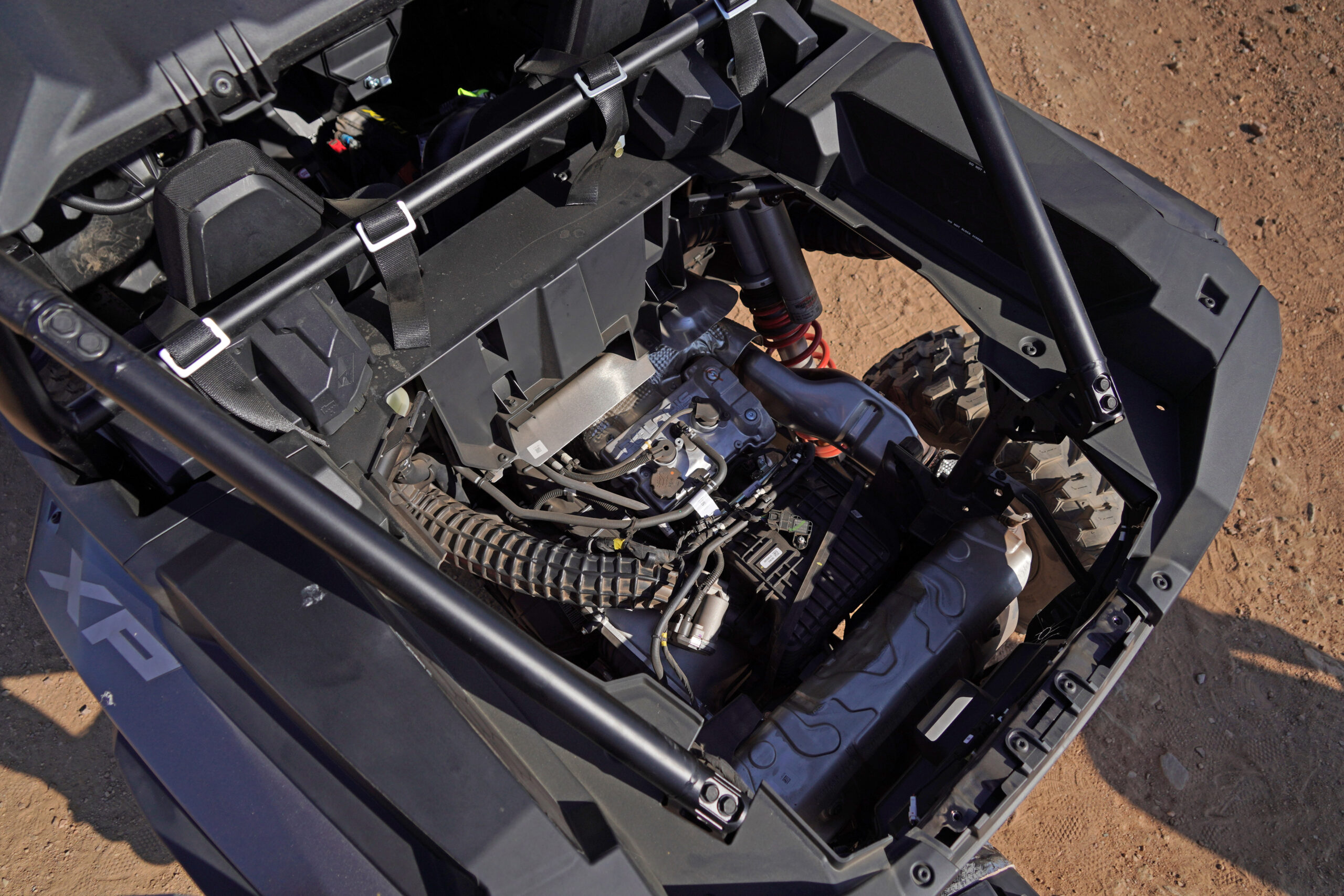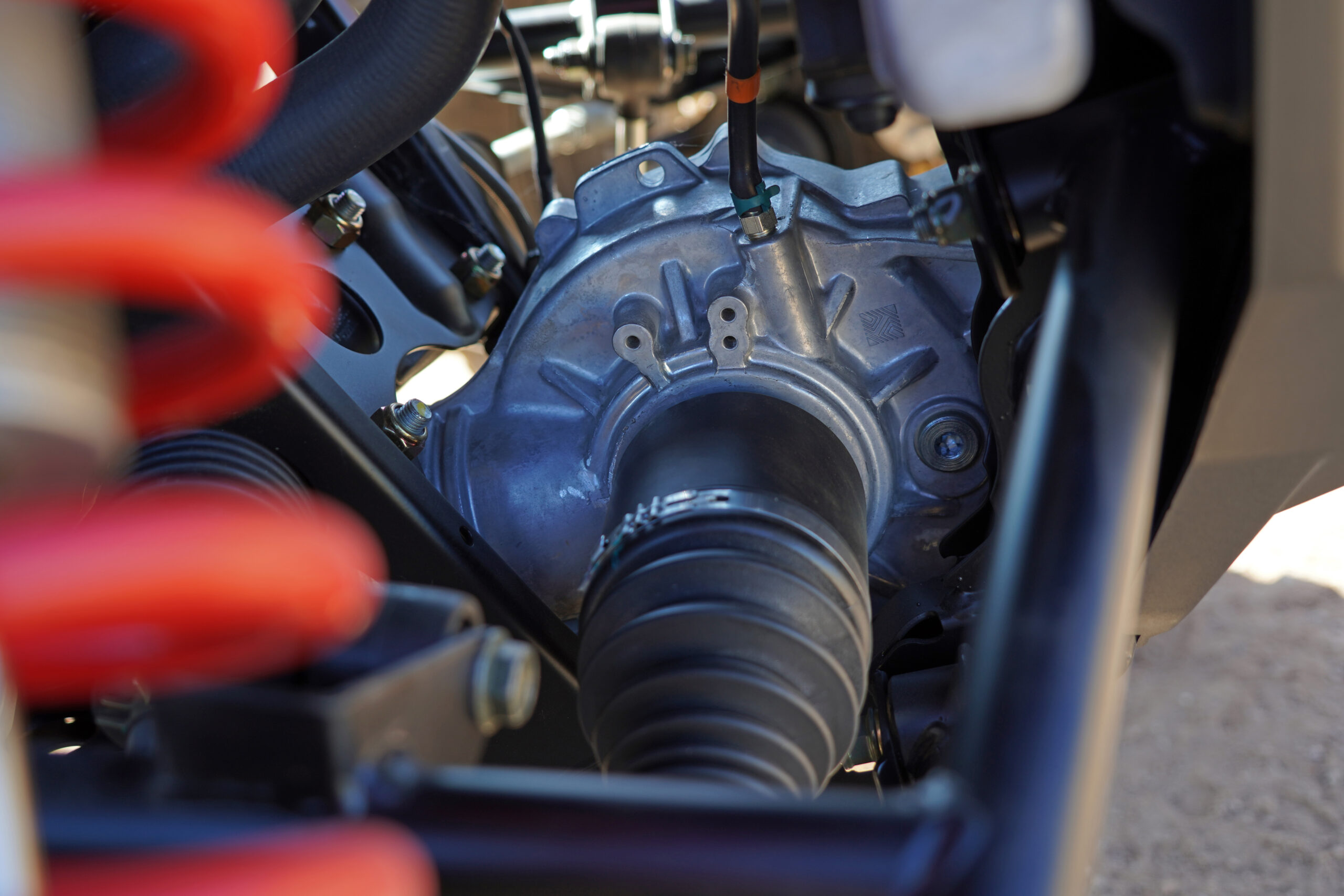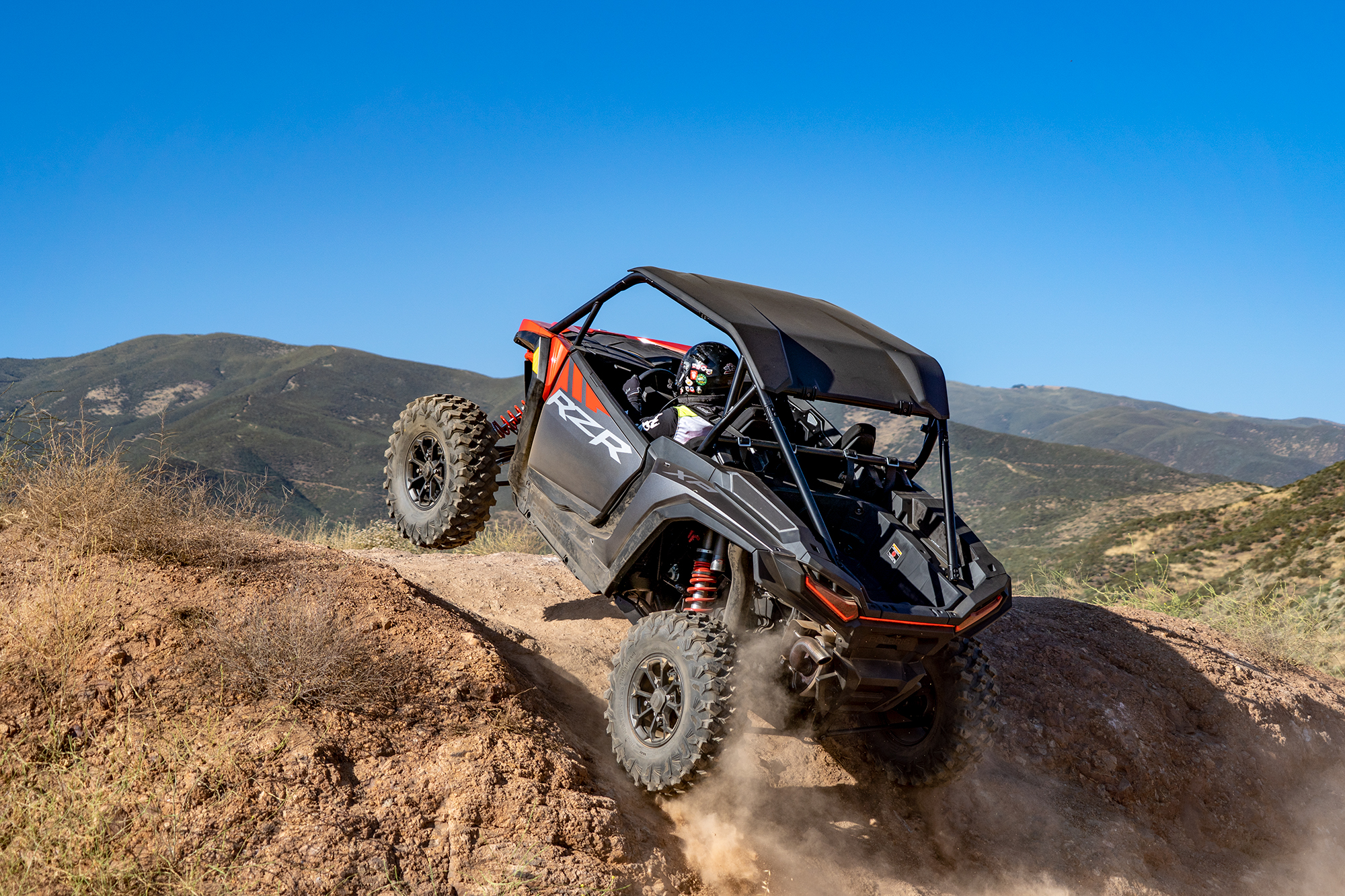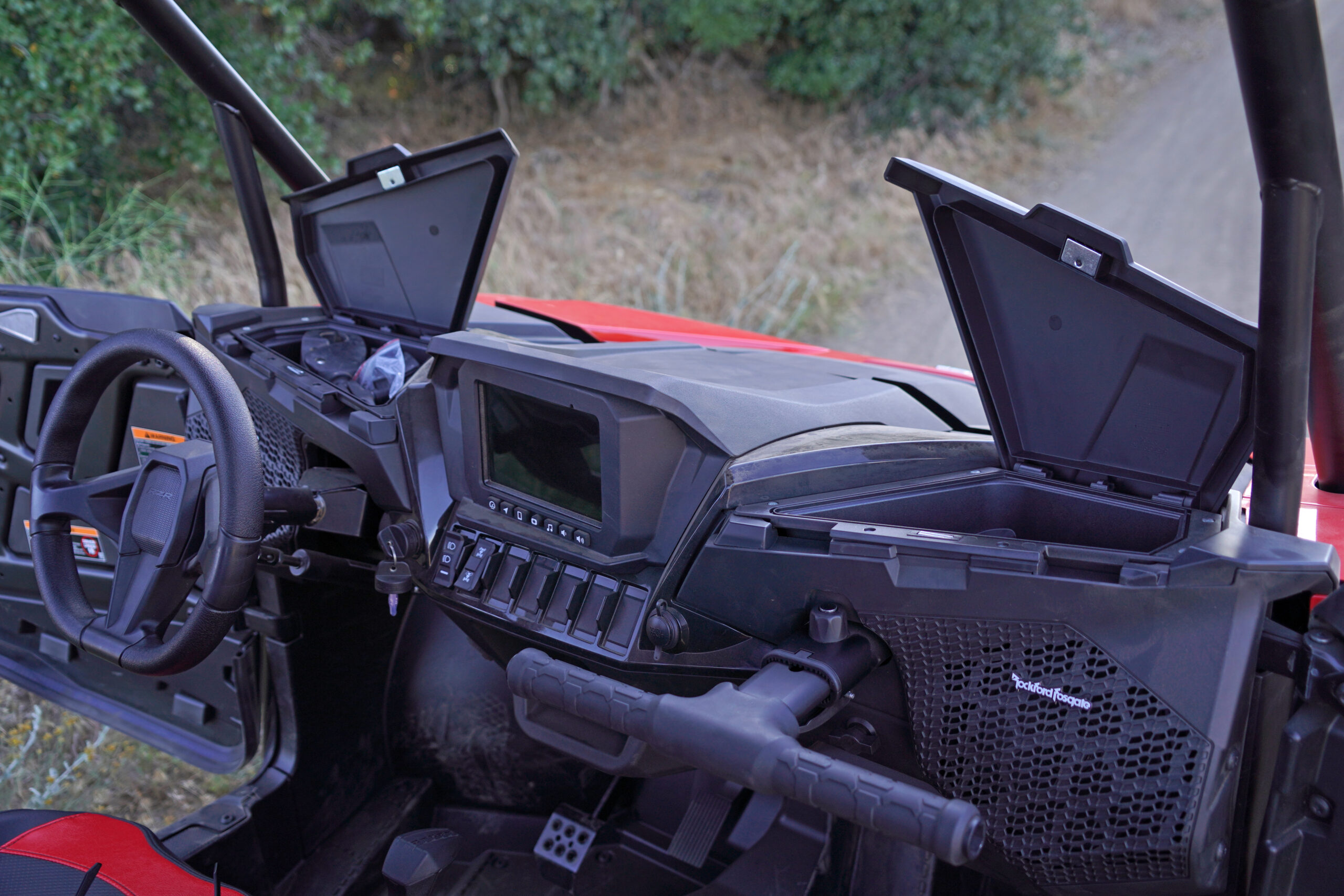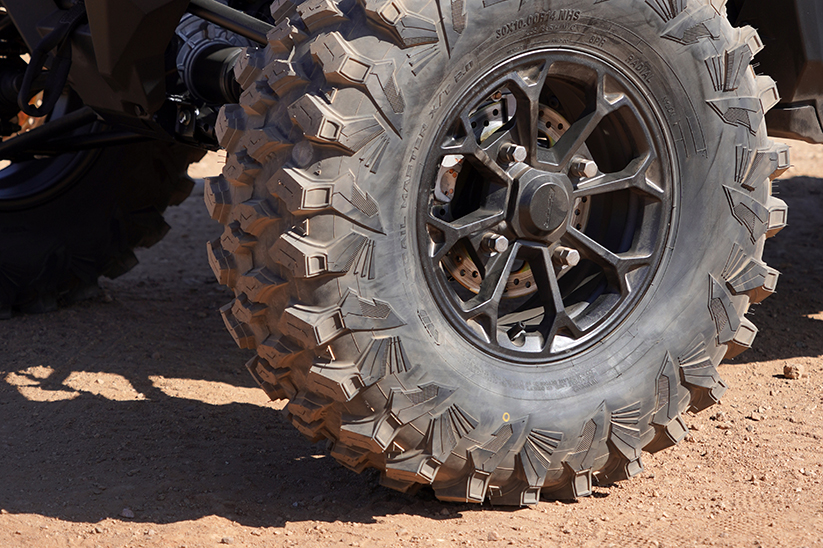2024 Polaris RZR XP 1000 Review
Engine:
The 2024 XP benefits from an all-new drivetrain front to back. This includes a new Gen 2 ProStar 1000 twin, which now sports a smoother power delivery and a little more twist down low. The engine and clutch tuning are fairly spot on, although the power seems to ramp on more smoothly and perhaps a little more slowly than the previous XP1000. This translates to a longer-feeling pedal, which is easier to control. The engine gives plentiful torque across a wide RPM range and doesn’t have to be flogged to carry the car down the trail at a good speed.
The new ProStar twin puts out 114 horsepower, which is only a few more than the previous model. The XP has the perfect amount of power for trail, woods, or mountain riding, and it is very easy to modulate. You can spend all day at partial trail climbing steep hills, and full throttle is really only ever reached if you’re on a long straight or really laying into a drift. If you’re looking for a big horsepower desert & dune whoop eater, there are faster options, but every single one of them costs more than the base model RZR XP Sport at $20,999.
Oil change intervals are said to be twice as long as the previous engine, which should make the ownership experience easier. The RZR’s engine can also be accessed freely by removing the four bolts that hold the bed pan in. Air filter access is now inside the cab, with a convenient quick-release panel between the seats.
Transmission/Drivetrain:
Polaris claims that the 2024 RZR XP’s driveline is 25% stronger than the RZR XP1000’s. Polaris has done this by redesigning every piece of it. The axles, diffs, driveshafts, and transmission are all beefed up, and the RZR gets a new geared reverse drive instead of a chain-driven one for better durability in sticky situations. The front differential is now mounted using rubber isolators, which is said to reduce driveline shock and improve comfort and durability.
Lower transmission gearing means the RZR feels like it engages more smoothly and with less effort. The engine and transmission feel better paired in the new RZR, but it still suffers from the same gateless, rubbery shifter. We had a couple instances when changing gears on-trail that ended in a false neutral situation when the car indicated it was in gear. The drivetrain and clutches make a fair amount of clunking noise, but if you’ve been around a Polaris RZR before, it won’t sound out of place. For a car this nice, these areas could definitely improve.
Suspension:
While Polaris didn’t give the XP any more wheel travel than the previous generation, they improved the quality of that travel significantly. The Ultimate trim model we drove had Walker Evans Needle Valve shocks with dual rate front and triple rate rear springs. The same shock package is fitted to all three trim levels of the XP1000 for 2024, so there’s no real performance advantage to moving up a trim other than one inch taller tires. Most of the options fitted to the upper Premium and Ultimate trims are related to creature comforts like audio equipment, Ride Command infotainment, and 4 point harnesses.
Polaris also completely revamped the RZR XP’s steering, which now features a quick ratio 1.5:1 steering rack. The changes to the suspension and steering together make for an incredibly agile and easy to drive car. Steering wheel motion at speed compared to the older XP1000 is reduced quite drastically, and the new EPS tune is spot on with a great return to center feel. The front and rear of the car are incredibly glued down to the trail, and the stiff swaybars only really show themselves in deep bumps.
The RZR has an incredibly well-tuned ride for rocky or rutted terrain, anywhere that exhibits high-frequency bumps on the trail surface. The Walker shocks tune that stuff out beautifully while still leaving more than enough bottoming resistance to soak up a big G-out. We didn’t touch a single clicker during our testing, remarking at how well-tuned the car came out of the box compared to some previous models we had driven. Even with two 200+ pound passengers in the car, it held itself up in the bumps well and we only bottomed a front shock twice during our testing. Both were in predictable situations, and the car didn’t exhibit any sign of it except for an audible clunk when it touched the stops.
Interior:
On the inside, this RZR XP is a massive improvement over its replacement in pretty much every way. Our Ultimate trim model was fitted with Ride Command and a 4-speaker Rockford Fosgate sound system. The Ride Command functions as the sole instrumentation for the car, replacing a driver-centered cluster adjacent to the ride command screen. For us, it was a welcome trade-off, as you receive dual upper-dash glove boxes in its place. The extra storage is a great benefit, and holds your phone, sunglasses, a rag for your goggles, a spare pair of gloves, etc. It also gives you a clear view of the instruments no matter the height of the driver, as the steering wheel is never in the way. Polaris even made the very left button on the Ride Command controls a shortcut back to gauges so you can do it without even looking on the trail.
Knee room is drastically improved. The cab is widened at the hip, knee, and shoulder areas, creating a lot more room for larger drivers. The doors now feature a bowed and dished profile similar to the Pro XP platform, which gives a comfortable spot for a knee rest and a ton of room. They also open like a traditional car door now, although the rear doors on the new RZR XP 4 still open backwards. The floorboard and footwell room is greatly improved over the last RZR as well, with multiple angled footrest options and a flat spot to put your outside foot, which was missing from the previous car. The dash is also now sculpted up and away from the occupants for more knee clearance around the center console.
The seats are comfortable, but the 4 point harnesses on the upper trims could use some refinement. They aren’t as comfortable as most aftermarket harnesses and the adjustment mechanisms leave something to be desired. The T-shaped grab bar in front of the passenger doubles as a tire iron, with an 18mm and 19mm hex socket built into the ends of the grip. The bar itself is wonderful, but the method in which you adjust its tightness and remove it will frustrate you if you ride with gloves on.
Another lower glovebox under the T-bar holds a ton of stuff. Unfortunately, you don’t get any extra room behind the seats like you do in a KRX1000, so you can’t hang a backpack or hydration pack behind the seats. Overall, the new RZR XP interior is great, from either seat.
Tires/Wheels/Brakes:
The entry-level RZR XP Sport gets 29-inch Trail Master X/T tires, while the upper trims get 30-inch Trail Master X/T tires. While they share the same name, the two tires have very different tread patterns. The tires we drove on, which are the 30-inch Trail Master X/Ts, looked an awful lot like a Maxxis Carnivore with the center lugs rotated. The tires perform wonderfully, providing a great balance of grip and predictable side slip that really compliment the way the XP is tuned.
The 14 inch aluminum wheels on our RZR XP test rig looked great, and Polaris skipped the beadlocks for this model. At this price point, it would be a nice addition, although it’s not often you’d ever need it. The bed is too narrow to lay a spare tire down, so you’ll have to stand it up or use an accessory rack.
The brakes on the XP work well, but the pedal feel is quite sloppy and could be tuned to feel a bit better. The brakes are always there when you need them, and they hold the car on steep inclines very well. There is enough braking power to lock up all four tires at will.


